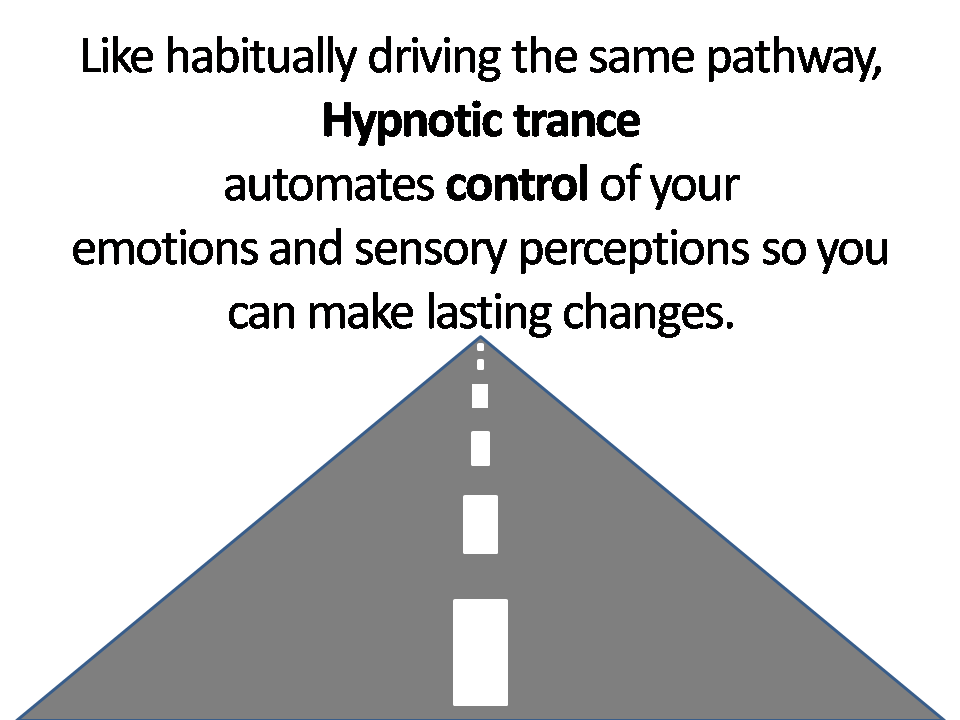THINK YOU CAN’T BE HYPNOTIZED?
Harvard’s study demonstrates intelligent people intuitively go into trance states. Have you ever spaced out and missed your exit on the freeway? Or, have you ever lost track of time? These are hypnotic trances.
With practice, a simply induced trance can practically give you the superpower to personally change your daily life. By purposely making a trance state an ordinarily performed routine, you can effortlessly empower a healthier, happier lifestyle.

When you consistently practice trance…
- Before getting out of bed in the morning, you can calmly raise focus and purpose.
- After climbing into bed, you can deeply and soundly fall asleep and wake refreshed.
Evidence undeniably proves hypnosis spontaneously generates abilities to ignore noise, control pain, lose weight by reorganizing your perceptions, emotions and cravings, making the things you desire comfortably familiar and ordinarily habitual.

Things like…
- Self-worth and confidence
- Healing betrayal and emotional eating
- Smoking cessation without weight gain or rage
Because we all have things we want to improve, change or get rid of, this all sounds really good, right?
Then, how are these changes precisely done? Ordinarily, we automatically run on subconscious thoughts that repeatedly trigger feelings and sensations. If these automatic states are routinely less-than-positive, we get less-than-positive results. By opening your unconscious mind and systematically cycling the desired states, you can effortlessly install preferred routines and habits.
By guiding you to relax and calmly opening your mental/emotional filtering system, hypnosis easily enables you to use 100% of your conscious and subconscious minds to naturally reach your desired state.

Like little kids playfully visualizing and daydreaming ourselves into the desires of our hearts, hypnosis intuitively uses your imagination to liberate you to live life your way. Hypnosis easily allows you to spontaneously transform by simply changing how you deeply perceive yourself.

FOR COMPLETELY INDIVIDUALIZED INFORMATION TEXT ME 909-300-5665
PREGNANT WOMEN ARE LEARNING TO ALLEVIATE POSTPARTUM DEPRESSION

Supporting an anxious pregnant woman by listening, and helping her to identify and ease fearful thoughts before giving birth, may help to naturally control postpartum depression.
Recently, Johns Hopkins Bloomberg School of Public Medicine conducted a study of randomly assigned anxious pregnant women, some receiving typical prenatal care and others received six sessions where they learned to identify fearful thoughts and behaviors, such as fear of miscarriage, and practice replacing them with helpful ones. The first five sessions were conducted in early to mid-pregnancy and the last session occurred in the last trimester.
Postpartum depression was cut from 41% in the typical care group to 12% merely by offering an intervention where women can identify and talk about their fears and learn to replace fears, using positive techniques such as cognitive behavior coaching.
How can I help her?

Many pregnant women face struggles with security in relationships and financial. Some don’t readily share their struggles. You don’t need to be an expert. Merely being there and listening can help her dispel negative worries and thoughts. If she is interested, you can help her go through the cognitive distortions listed below and ease them by realizing a new way of thinking about them. If she still has lingering worries, help her get the support and information she needs. It is important to help her find calm early for a healthful pregnancy and baby.
If you are pregnant and anxious…

- Find someone that listens to talk about your fears. Support is really important! Especially from women that have experience. Listen to their stories. Find out more information.
- Trust that you are strong enough to meet any challenge.
- Just breathing and keeping a grateful mind are the best start to lowering your anxiety.

Because most fear is based in heavy emotion, we can ask, “Is it a fact or a feeling?” If there are no facts to support the feeling, going over this list of distortions and finding the reasoning employed to arrive at the feeling, enables you to replace it with more positive thoughts and emotions. Here are some examples from Harvard Health:
- All-or-Nothing (or Black-or-White) thinking (Nothing is ever going to get better)
- Ask yourself: Nothing? Ever?
- Mind-Reading (Jumping to conclusions like; I know he doesn’t like me)
- Ask: Did he say so?
- Personalize or Blame self and others (It is because of me)
- Ask: Do I have that much power to really be responsible?
- “Should”ing and “must”ing pressure
- Ask: Can I do it or would I do it and when will I do it?
- Doom colored glasses (always looking at the negative) This is awful!
- And I am grateful that…, Find the one positive thing.
- Over-generalizing (never, always,)
- Ask: Always?
- Mountain out of a molehill, magnifying negative and minimizing positive.( I only won once)
- Ask: Am I am grateful or glad for winning?
- Fortunetelling (My lab tests will be out of control)
- Ask: Is this fact or feeling?
- Comparison(Everyone looks better than me)
- Ask: What are my positive strengths, skills and attributes?
- Catastrophizing ( thinking the worst and blowing it out of proportion)
- Ask: If that did happen, what is the result? What are the chances that it will?
- Disqualifying good (I won that hand but it was beginners luck)
- And I am grateful for beginners luck and winning.
If you know someone that is pregnant and anxious about it support her by listening.

Help her find new ways of thinking to ease her anxiety. Having social love and support helps.
If you find you still need freedom from fearful thoughts and emotions, Please feel free to contact me for a complimentary strategy call at 909-300-5665. I would love to support you during this crucial time in yours and your baby’s lives.


